Unit 4 Making the news 教学设计4-公开课-优质课(人教必修5精品)
- 格式:doc
- 大小:102.50 KB
- 文档页数:19
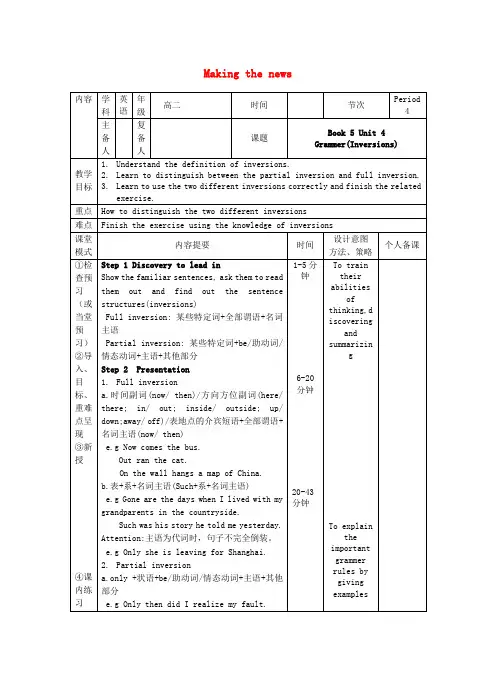
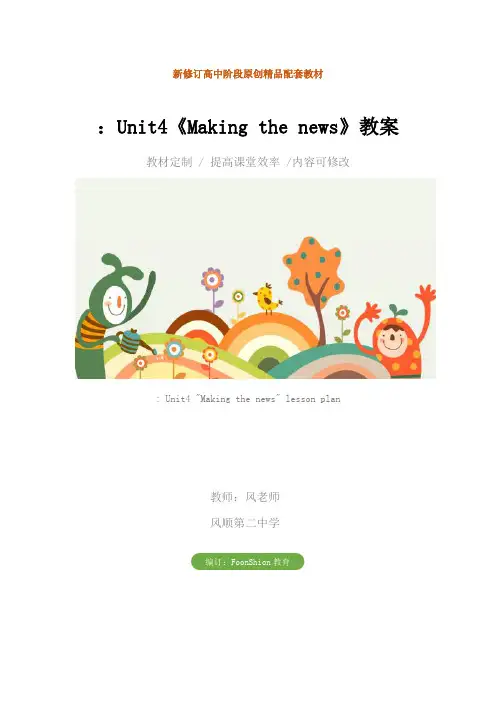
新修订高中阶段原创精品配套教材:Unit4《Making the news》教案教材定制 / 提高课堂效率 /内容可修改: Unit4 "Making the news" lesson plan教师:风老师风顺第二中学编订:FoonShion教育:Unit4《Making the news》教案:unit4《making the news》教案(新人教版必修5)一. 全模块教学目标(teaching aims)1. 能力目标(ability aim)enable the ss to recognize the variety of jobs there are in newspapers and what is needed to work in a newspaper office.enable the ss to know what is needed to become a reporter and how to conduct an interview.2.. 语言目标(language aim)重点词汇和短语occupation, update, submit, cover, concentrate on, inform, publish, polish, approve, acquire, accuse…of, so as to, scoop, deadline, depend on, ahead of, assess, demand, process 重点句子1)never will zhou yang forget his first assignment at the office of a popular english newspaper.2)you’ll find your colleagues very eager to assist you, so youmay be able to concentrate on photography later if you’re interested .3)not only am i interested in photography, but i took an amateur course at university to update my skills.4)only if you ask many questions will you acquire all the information you need to know.5)we say a good journalist must have a good “nose” for a story.6)meanwhile you have to prepare the next question depending on what the person says.7)have you ever had a case where somebody accused your reporters of getting the wrong end of the stick?8)perhaps i too will get a scoop!aids: multimedia facilities, tape-recorder, photos, diagrams二. 教学重难点(teaching important points)know what is needed to become a reporter and how to conduct an interviewmaster the use of inversion.三. 教学方法(teaching method)fast reading; task-based method & discussion四. 教学步骤(teaching procedure)period iiistep i check the homework and the recitation etc.step ii finish off the text of reading on p26 and deal the language points,1. acquirevt. (经由努力而) 获得,学得<知识、学问等=to get by one's own efforts:取得,获得:通过自我努力获得:acquire proficiency in math. 在数学上达到熟练水平acquire knowledge/ information, etc.2.have a good nose for sth = have an eye for …/ have an ear for .. 有眼光/ 对..感兴趣she has an ear for music .a good reporter has a nose for news . 对……嗅觉灵敏3.assess = make a judgement about a person or situation after thinking carefully about it评定;判断4.meanwhile adv = in the meanwhile / in the meantime / at the same time5.skeptical = a. 怀疑的= tending to doubt or not believe what other people tell youmary is sceptical about the solution. 玛丽对这个解决办法表示怀疑。
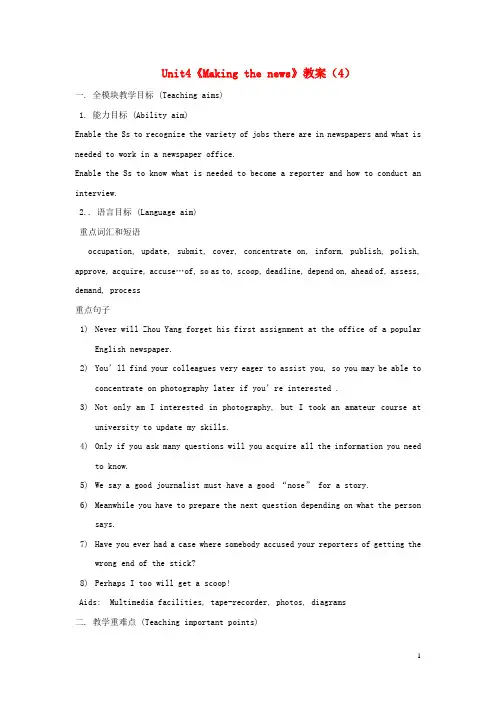
Unit4《Making the news》教案(4)一. 全模块教学目标 (Teaching aims)1. 能力目标 (Ability aim)Enable the Ss to recognize the variety of jobs there are in newspapers and what is needed to work in a newspaper office.Enable the Ss to know what is needed to become a reporter and how to conduct an interview.2.. 语言目标 (Language aim)重点词汇和短语occupation, update, submit, cover, concentrate on, inform, publish, polish, approve, acquire, accuse…of, so as to, scoop, deadline, depend on, ahead of, assess, demand, process重点句子1)Never will Zhou Yang forget his first assignment at the office of a popularEnglish newspaper.2)You’ll find your colleagues very eager to assist you, so you may be able toconcentrate on photography later if you’re interested .3)Not only am I interested in photography, but I took an amateur course atuniversity to update my skills.4)Only if you ask many questions will you acquire all the information you needto know.5)We say a good journalist must have a good “nose” for a story.6)Meanwhile you have to prepare the next question depending on what the personsays.7)Have you ever had a case where somebody accused your reporters of getting thewrong end of the stick?8)Perhaps I too will get a scoop!Aids: Multimedia facilities, tape-recorder, photos, diagrams二. 教学重难点 (Teaching important points)Know what is needed to become a reporter and how to conduct an interviewMaster the use of inversion.三. 教学方法 (Teaching method)Fast reading; Task-based method & discussion四. 教学步骤 (Teaching procedure)Period IIIStep I Check the homework and the recitation etc.Step II finish off the text of reading on p26 and deal the language points,1. acquirevt. (经由努力而) 获得,学得 <知识、学问等=To get by one's own efforts:取得,获得:通过自我努力获得:acquire proficiency in math. 在数学上达到熟练水平acquire knowledge/ information, etc.2.have a good nose for sth = have an eye for …/ have an ear for .. 有眼光/ 对..感兴趣She has an ear for music .A good reporter has a nose for news . 对……嗅觉灵敏3.assess = make a judgement about a person or situation after thinking carefully about it评定;判断4. Meanwhile adv = in the meanwhile / in the meantime / at the same time 5. skeptical = a. 怀疑的= tending to doubt or not believe what other people tell youMary is sceptical about the solution. 玛丽对这个解决办法表示怀疑。
![[教案]Unit4MakingtheNews (4)](https://uimg.taocdn.com/88d6f6a31b37f111f18583d049649b6648d70984.webp)
Unit4 Making the News【教材分析】本单元的中心话题是“新闻”。
话题依附于热身、阅读、语言学习、语言使用、听力、口语与写作等语言载体中。
内容涉及新闻工作者应该具备的素质、制作新闻的基本程序以及报纸和电视节目。
“热身”(warming up)局部通过讨论将来想从事的工作,使学生理解多种职业类别,协助学生理解报社工作人员的各种类别和所需承担的职责。
重点在于“types of jobs”和“What is involves?”“读前”(Pre-reading)局部通过调查问卷引导学生思考他们眼中优秀的新闻记者应该具备的素质,为文章涉及的内容“What is needed to become a good reporter?”做了铺垫。
学生通过讨论他们人生中各种“第一次”的经历和感受,为下一局部阅读的展开做了准备。
“阅读”(reading)局部通过周阳---一位刚刚走上新闻工作岗位的记者和他的上司胡星---一位经验丰富的资深新闻工作者之间的对话,通过阅读,引导学生理解并意识到作为新闻工作者应该具备的素质、新闻制作的基本程序以及新闻工作者在采访过程中应该注意的细节要点。
通过阅读局部所设计的一些教学活动来协助学生加深对文章内容的理解。
“语言学习”(learning about language)局部归纳和使用了本单元的重点词汇和短语。
协助学生分析和掌握倒装句的语法项目。
“语言使用”(Using language)局部包含了读、听、说等基本语言技能。
第一局部学生通过阅读“获得独家新闻”,一方面理解新闻写作的基本步骤和新闻制作的相关程序,另一方面学生通过想象来讨论文中所提到的“著名影星”可能说的谎言,在此基础上引导学生象周阳一样写出一篇关于此“著名影星”的独家新闻。
第二局部是周阳想采访刘明关于他去国外工作的决定,和刘明的助手商谈安排采访刘明的对话。
通过练习来协助学生获取要点和细节,提升他们听的水平。
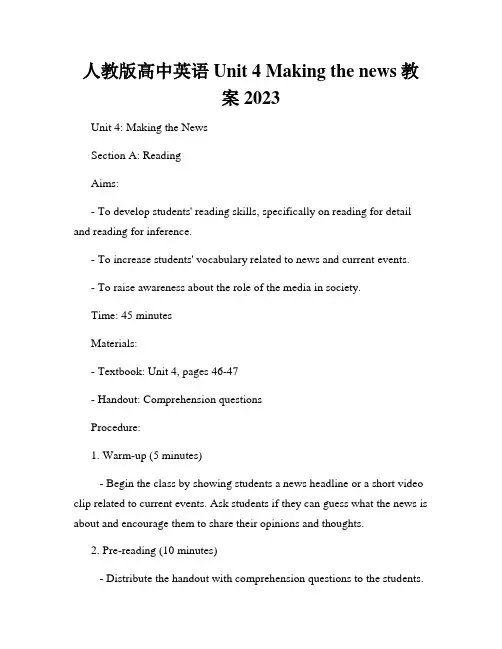
人教版高中英语Unit 4 Making the news教案2023Unit 4: Making the NewsSection A: ReadingAims:- To develop students' reading skills, specifically on reading for detail and reading for inference.- To increase students' vocabulary related to news and current events.- To raise awareness about the role of the media in society.Time: 45 minutesMaterials:- Textbook: Unit 4, pages 46-47- Handout: Comprehension questionsProcedure:1. Warm-up (5 minutes)- Begin the class by showing students a news headline or a short video clip related to current events. Ask students if they can guess what the news is about and encourage them to share their opinions and thoughts.2. Pre-reading (10 minutes)- Distribute the handout with comprehension questions to the students.- Instruct them to read the questions silently and underline any unfamiliar vocabulary.- Give students a few minutes to discuss their answers in pairs or small groups.3. Reading (20 minutes)- Direct students' attention to the textbook and ask them to read the passage individually.- Encourage them to underline key information and make notes in the margins.- Monitor their progress and provide assistance if needed.- After reading, ask students to compare their answers to the comprehension questions with a partner before discussing them as a whole class.4. Post-reading (10 minutes)- Lead a class discussion about the role of the media in society.- Ask students questions such as:- What impact does news reporting have on individuals and society?- How does the media influence public opinion?- What responsibilities do journalists have when reporting news?- Encourage students to express their opinions and support their arguments with examples from the reading.5. Extension activity (optional)- Have students choose a current news story and write a short summary or analysis of it, keeping in mind the discussion about media influence.- Alternatively, students can work in pairs or small groups to present a role play, portraying journalists reporting on a breaking news story.6. Homework (5 minutes)- Assign a reading task related to news or current events from the textbook or additional reading materials.- Ask students to write a short reflection on what they have learned in class and any questions or ideas that have arisen from the lesson.Assessment:- Observe students' participation in class discussions and their ability to express opinions and support arguments.- Evaluate students' comprehension through their responses to the comprehension questions.- Review students' homework assignments for their reflection and understanding of the lesson.Note: Adapt the lesson plan according to the needs and abilities of the students and the available resources.。
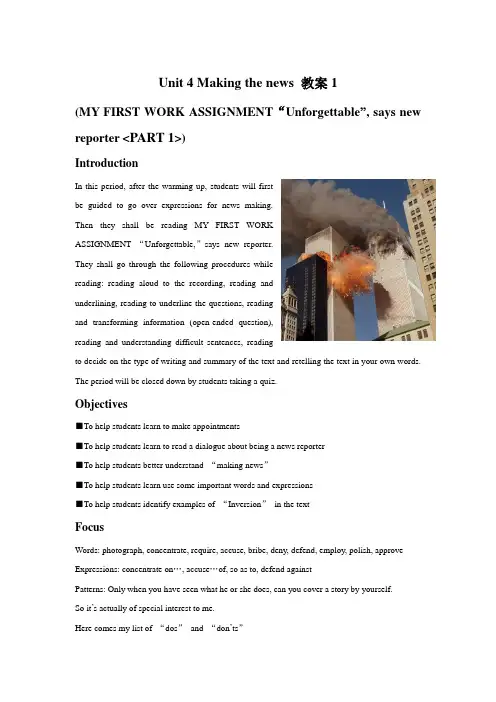
Unit 4 Making the news 教案1(MY FIRST WORK ASSIGNMENT“Unforgettable”, says new reporter <PART 1>)IntroductionIn this period, after the warming up, students will firstbe guided to go over expressions for news making.Then they shall be reading MY FIRST WORKASSIGNMENT “Unforgettable,”says new reporter.They shall go through the following procedures whilereading: reading aloud to the recording, reading andunderlining, reading to underline the questions, readingand transforming information (open-ended question),reading and understanding difficult sentences, readingto decide on the type of writing and summary of the text and retelling the text in your own words. The period will be closed down by students taking a quiz.Objectives■To help students learn to make appointments■To help students learn to read a dialogue about being a news reporter■To help students better understand “making news”■To help students learn use some important words and expressions■To help students identify examples of “Inversion”in the textFocusWords: photograph, concentrate, require, accuse, bribe, deny, defend, employ, polish, approve Expressions: concentrate on…, accuse…of, so as to, defend againstPatterns: Only when you have seen what he or she does, can you cover a story by yourself.So it’s actually of special interest to me.Here comes my list of “dos”and “don’ts”This is a trick of the trade.This is how the story goes.Later we were proved right.AidsMultimedia facilities, tape-recorder, photos, diagramsProcedures1. Warming up⑴ Warming up by discussingThink like a reporterHi, everyone. Today we will learn something about making the news. Suppose you work for China Daily, what types of jobs do you choose? What does it involve? Now in pairs discuss them. Give reasons for your choice.Types of jobs: What it involvesReporter Interviews people or finds out about events from onlookersPhotographer Takes photographs of important people or eventsEditor Makes sure the writing is clear, concise and accurate; checks factsDesigner Lays out the article and photographsPrinter Prints the newspaperWell done! By the way, have you ever heard “journalist”? Is there any difference between journalist and reporter? Ordinarily speaking, a reporter is a person whose job is to discover information about news events and describe them for a newspaper or magazine or for radio or television. And a journalist is a person who writes news stories or articles for a newspaper or magazine or broadcasts them on radio or television. Maybe in Chinese we can understand it better: reporter; journalistreporter=news reporter“新闻记者”,特指外出采访的记者。
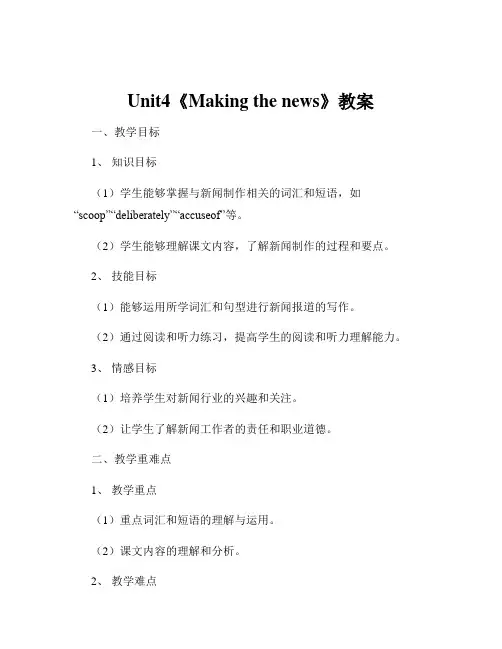
Unit4《Making the news》教案一、教学目标1、知识目标(1)学生能够掌握与新闻制作相关的词汇和短语,如“scoop”“deliberately”“accuseof”等。
(2)学生能够理解课文内容,了解新闻制作的过程和要点。
2、技能目标(1)能够运用所学词汇和句型进行新闻报道的写作。
(2)通过阅读和听力练习,提高学生的阅读和听力理解能力。
3、情感目标(1)培养学生对新闻行业的兴趣和关注。
(2)让学生了解新闻工作者的责任和职业道德。
二、教学重难点1、教学重点(1)重点词汇和短语的理解与运用。
(2)课文内容的理解和分析。
2、教学难点(1)如何引导学生将所学知识应用到实际的新闻写作中。
(2)让学生理解新闻工作中的道德和伦理问题。
三、教学方法1、任务型教学法通过布置各种任务,如阅读、写作、讨论等,让学生在完成任务的过程中掌握知识和技能。
2、情景教学法创设新闻制作的情景,让学生身临其境,更好地理解和掌握教学内容。
3、合作学习法组织学生进行小组合作学习,共同完成任务,培养学生的合作精神和沟通能力。
四、教学过程1、导入(1)通过展示一些著名的新闻图片或视频片段,引起学生对新闻的兴趣。
(2)提问学生对新闻制作的了解程度,引导学生思考新闻是如何产生的。
2、词汇学习(1)讲解课文中的重点词汇和短语,如“scoop”“deliberately”“accuseof”等,通过例句让学生理解其用法。
(2)组织学生进行词汇练习,如填空、造句等,巩固所学词汇。
3、课文阅读(1)让学生快速阅读课文,了解课文的大意。
(2)提出一些问题,如“What is the main idea of the text?” “Who ar e the main characters in the text?”等,检查学生的阅读理解情况。
(3)详细分析课文,讲解课文中的重点句子和段落,帮助学生深入理解课文内容。
4、听力练习(1)播放课文的录音,让学生边听边跟读,提高学生的听力和口语水平。
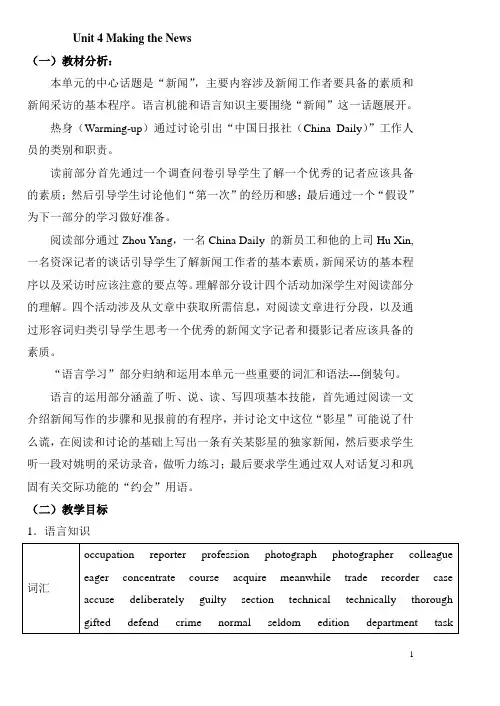
Unit 4 Making the News(一)教材分析:本单元的中心话题是“新闻”,主要内容涉及新闻工作者要具备的素质和新闻采访的基本程序。
语言机能和语言知识主要围绕“新闻”这一话题展开。
热身(Warming-up)通过讨论引出“中国日报社(China Daily)”工作人员的类别和职责。
读前部分首先通过一个调查问卷引导学生了解一个优秀的记者应该具备的素质;然后引导学生讨论他们“第一次”的经历和感;最后通过一个“假设”为下一部分的学习做好准备。
阅读部分通过Zhou Yang,一名China Daily 的新员工和他的上司Hu Xin, 一名资深记者的谈话引导学生了解新闻工作者的基本素质,新闻采访的基本程序以及采访时应该注意的要点等。
理解部分设计四个活动加深学生对阅读部分的理解。
四个活动涉及从文章中获取所需信息,对阅读文章进行分段,以及通过形容词归类引导学生思考一个优秀的新闻文字记者和摄影记者应该具备的素质。
“语言学习”部分归纳和运用本单元一些重要的词汇和语法---倒装句。
语言的运用部分涵盖了听、说、读、写四项基本技能,首先通过阅读一文介绍新闻写作的步骤和见报前的有程序,并讨论文中这位“影星”可能说了什么谎,在阅读和讨论的基础上写出一条有关某影星的独家新闻,然后要求学生听一段对姚明的采访录音,做听力练习;最后要求学生通过双人对话复习和巩固有关交际功能的“约会”用语。
(二)教学目标1.语言知识2.语言技能3.学习策略4.教学的重点和难点(1)重点1)了解新闻工作者的基本素质,新闻采访的基本程序以及采访时应该注意的要点等2)学会约会3)语法项目---倒装句4)了解新闻写作的步骤和见报前的有程序5)让学生初步学会运用所学的新闻报导的知识进行新闻文章写作(2)难点1)让学生归纳出新闻工作者的基本素质2)让学生灵活运用功能用语进行约会场景交流3)让学生初步学会写新闻报道文章(三)教学安排Period 1: Warming up (p25); Listening (p62)Period 2: Reading (p26); Comprehending (p27)Period 3: Discovering useful words and expressions (p27-28)Period 4: Discovering useful structures (p29) ;Using structures (p.64)Period 5: Reading and writing (p30-31)Period 1Teaching Contents: Warming up (p25); Listening (p62)Teaching proceduresStep 1 Lead-inWhere can we get the news from all over the world?Step 2 PresentationSuppose you were to be a journalist for China Daily, do you know what kind of jobs they have?Answer the questionsQ1: How many different kinds of jobs do newspapers have?Q2: What do these jobs involves?Q3: Do you know how to make the news? What’s the process?Step 3Talking1. If you want to be a good journalist, what qualities do you think you need to have?2. Divide the students into two groups to do an interview, one interviewee is Zhang Ziyi, another one is Yao Ming.After the interview, ask the students to answer the questions: What is your biggest problem to become a journalist? How can you change it?Step 4 ListeningListen to the story about Greg’s telephone interview and see whether h e had the same problems as you discussed.Period 2 ReadingTeaching contents: Reading (p26; Comprehending (p27)Teaching proceduresStep 1 Word preparationDelighted, colleague, assist, concentrate on, dilemma, submit, amateurStep 2 Lead-in1. Show some pictures of famous reporters2. How do they feel as a famous journalist?3. How would a new journalist feel to his first work assignment? (unforgettable) Step 3 SkimmingStep 4 ScanningLet’s read each part and find out more details in each part.Step5 ComprehendingStep 6 Idioms ExplanationStep7 Language difficultiesPeriod 3 Learning about languageTeaching contents: Discovering useful words and expressions (P27-28) Teaching procedures:Step 1 Discovering useful words and expressions1. In the reading passages several expressions are used in an idiomatic way. Findthem and fill in the chart.2. Complete Sentence B using a word or phrases from the reading passage which has and opposite meaning to the words underlined in the Sentence A3. Complete this passage using the words below in the correct form.Step2 Words studyPhrases:1.go out on a story 2. take photographs 3. be eager to do.. 4. take an amateur course 5.update my skills 6. depend on 7.accuse…of … 8. score goals 9. so as to.. 10.deny doing..Step 3 HomeworkPeriod 4 GrammarTeaching contents: Discovering useful structures (p. 29); Using structures (p.64) Teaching proceduresStep 1 Lead-in1. ---I don’t like the hair style.---Neither do I.2. Only when I took the plane did I first see the beautiful air hostess.3. Here comes a modern model with a long black dress.Step 2 Discovering1. Find the sentence using inversion in the reading passage.2. Rewrite the sentences using normal word order.(EX2 P29)3. Rewrite the sentences using inversion. (EX3 P29)4. Sentence making(EX 4 P29)1) Only after ______________ did______________.2) Not once did ____________________________.3) Seldom have I ____________________________.4) Only by doing _____________ could _______ .5) Only in a ____ can _______________________.6) Not once did _____________________________ .7) Only then did ____________________________.Step3 SummaryStep 4 PracticeStep 5 HomeworkReview the grammar focus and finish the exercises on page 64.Period 5 Reading & WritingTeaching contents: Reading and writing (p14-16)Teaching proceduresStep 1Word studyStep 2 Lead-inAs a reporter, Zhou Yang was eager to get a scoop. Now comes the chance. Let’s go to the text “ Getting the Scoop”Step 3 Reading1. What is the scoop about?2. What should be done before the scoop appear in the newspaper?3. How should be a good article like?Step 4 Language pointsStep 5 WritingLearn to write a news report.。
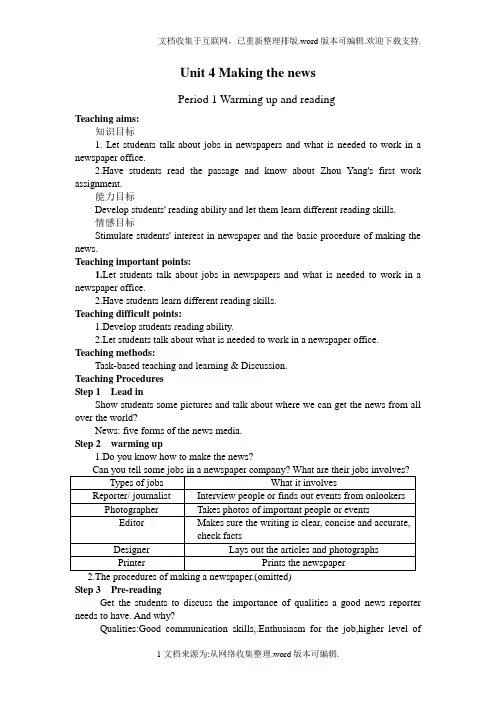
Unit 4 Making the newsPeriod 1 Warming up and readingTeaching aims:知识目标1. Let students talk about jobs in newspapers and what is needed to work in a newspaper office.2.Have students read the passage and know about Zhou Yang's first work assignment.能力目标Develop students' reading ability and let them learn different reading skills.情感目标Stimulate students' interest in newspaper and the basic procedure of making the news.Teaching important points:1.Let students talk about jobs in newspapers and what is needed to work in a newspaper office.2.Have students learn different reading skills.Teaching difficult points:1.Develop students reading ability.2.Let students talk about what is needed to work in a newspaper office. Teaching methods:Task-based teaching and learning & Discussion.Teaching ProceduresStep 1 Lead inShow students some pictures and talk about where we can get the news from all over the world?News: five forms of the news media.Step 2 warming up1.Do you know how to make the news?Step 3 Pre-readingGet the students to discuss the importance of qualities a good news reporter needs to have. And why?Qualities:Good communication skills,.Enthusiasm for the job,higher level ofeducation,hard working,Curious, active personality...enthusiasm = a strong feeling of interest and enjoyment about something and and eagerness to be involved in it.be full of enthusiasm about…热衷于……Step 4 Reading1.SkimmingWhat’s the main idea of this passage?This passage is about _______’s first _______ at the office of China Daily. And his ________ with his new _____, Hu Xin.Now please listen to the passage and underline the questions which Zhou Yang asks. Try tolook at the way the questions develop.⑴Can I go out on a story immediately?⑵What do I need to take with me?⑶What do I need to remember when I go out to cover a story?⑷What should I keep in mind?⑸Why is listening so important?⑹But how Can I listen carefully while taking notes?⑺Have you ever had a case where someone accused your journalists of getting the wrong end of the stick?2. ScanningTrue or False questions.(TFTFFF)1, Don’t go out on a story on your own at first.2, Take a notebook, a pen as well as a camera.3, Be curious and ask different questions to get all the information4, Talk too much during the interview.5, A reporter doesn’t need to listen to the detailed facts.6, We can always use small recorders to make sure that we get all our facts straight.3 . Careful readingPart 11.When could Zhou Yang cover a story by himself?Not till he is more experienced.2. Why is there no need for him to carry a camera?Because he will have a professional photographer with him to take photographs. Part 2:What does Zhou Yang need to remember when he goes out to cover a story?1.You need to be ______ and able to tell when people are ___________. In that case, you must use __________ or ___________ to find out the truth.2. Don’t be ____, don’t talk too much yourself and must _________________ carefully.3. While listening, you can use ______________ to make sure that you get all the facts ________. It also can provide ______ to support your story, if you are accused.Part 3: Are the following statements true or false?(FFFF)Hu Xin never had a case where somebody accused his reporters of getting the wrong end of the stick.The footballer was accused because he lost the game.The footballer admitted in the interview that he had taken some money from the man.The reporters found out the truth from the footballer’s words.Step 5 RevisionZhou Yang’s notes1.The skills needed2.The importance of listening3.Stages in researching a story4.How to check facts5.How to deal with accusations of liesStep 6 Homework1. Read the text by yourself and finish Ex 1 & 3. (P27-28)2. Read and find out the useful words and expressions in the reading text.。
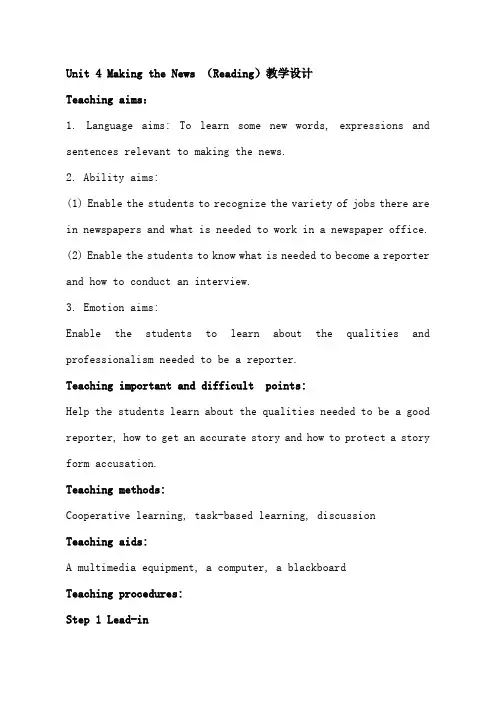
Unit 4 Making the News (Reading)教学设计Teaching aims:1. Language aims: To learn some new words, expressions and sentences relevant to making the news.2. Ability aims:(1) Enable the students to recognize the variety of jobs there are in newspapers and what is needed to work in a newspaper office.(2) Enable the students to know what is needed to become a reporter and how to conduct an interview.3. Emotion aims:Enable the students to learn about the qualities and professionalism needed to be a reporter.Teaching important and difficult points:Help the students learn about the qualities needed to be a good reporter, how to get an accurate story and how to protect a story form accusation.Teaching methods:Cooperative learning, task-based learning, discussionTeaching aids:A multimedia equipment, a computer, a blackboardTeaching procedures:Step 1 Lead-in1. Show a piece of news to the students.2. Show pictures of some people on the screen and ask the students to guess the jobs of them. (journalist, photographer, editor, designer, printer)3. Students turn their textbooks to page 26, read the title of the passage and find out the main characters quickly by scanning the passage.Step 2 SkimmingStudents skim the passage quickly and find out the main idea. (The qualities needed to become a good journalist.)Step 3 ScanningStudents are divided into seven small groups, scan the passage and finish the “True or False” questions.1. Zhou Yang needs a camera to become a good journalist. (F)2. A journalist needs to be curious.(T)3. A journalist shouldn’t be so talkative but should listen carefully.(T)4. A journalist should listen carefully while taking notes.(T)5. Zhou Yang has got a real scoop.(F)Step 4 Detailed reading1. Students read line 1-15 carefully and fill in the blanks. (1)The first time he will be put as an assistant to an experiencedjournalist.(2) There is no need for him to take a camera with him. Hewill have a professional photographer with him to take photographs.2. Students read line 16-29 carefully and fill in the blanks.(1) He needs to be curious.(2) A good reporter must have a “nose” for a story.(3) He has to listen for detailed facts.(4) If the interviewee agrees, he can use a recorder to get the facts straight.3. Students read line 30-41 carefully and finish the “True or False” questions.(1) Hu Xin ever had a case where somebody accused his journalists of getting the wrong end of the stick.(2) The footballer was accused because he lost the game.Step 5 SummaryHelp the students to summarize the main idea of each part as well as the whole passage.Part 1(line1-15): Welcome to work in a teamPart 2(line16-29): How to cover a story; dos &don’tsPart 3(line30-41): How to protect a story from accusations Step 6 Homework1. Read the passage as fluently as you can, and practice reading it with your partner.2. Write a short passage with the title of “What Makes a Good Journalist?” in about 100 words.Reference words, expressions and sentences:1. experienced2. gifted3. curious4. professional5. patient6. creative7. high level of education8. work experience9. good communication skills10.enthusiasm for the job11. prepared to work long hours12. ability to work in a team13. A good journalist need to be…14. In order to get accurate news, a journalist should…15. Only if you… can you…16. One should keep in mind that…when going out to cover a story.。
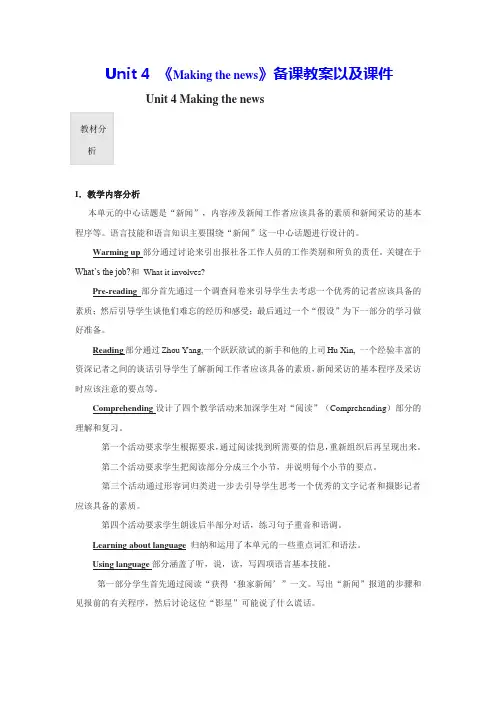
Unit 4 《Making the news》备课教案以及课件Unit 4 Making the newsI.教学内容分析本单元的中心话题是“新闻”,内容涉及新闻工作者应该具备的素质和新闻采访的基本程序等。
语言技能和语言知识主要围绕“新闻”这一中心话题进行设计的。
What’s the job?和What it involves?素质;然后引导学生谈他们难忘的经历和感受;最后通过一个“假设”为下一部分的学习做好准备。
资深记者之间的谈话引导学生了解新闻工作者应该具备的素质,新闻采访的基本程序及采访时应该注意的要点等。
理解和复习。
第一个活动要求学生根据要求,通过阅读找到所需要的信息,重新组织后再呈现出来。
第二个活动要求学生把阅读部分分成三个小节,并说明每个小节的要点。
第三个活动通过形容词归类进一步去引导学生思考一个优秀的文字记者和摄影记者应该具备的素质。
第四个活动要求学生朗读后半部分对话,练习句子重音和语调。
第一部分学生首先通过阅读“获得‘独家新闻’”一文。
写出“新闻”报道的步骤和见报前的有关程序,然后讨论这位“影星”可能说了什么谎话。
第二部分首先听一段对篮球明星姚明的采访。
随后的练习设计既训练了学生获取要点的能力,又引导学生如何获取细节。
最后要求学生通过开展两人对话活动复习巩固有关交际功能“约会”的用语。
测。
荐一些给学生,或让学生自己推荐一些他们认为好的英文报纸。
II.教学重点和难点1. 教学的重点:(1) 简要了解新闻工作者应该具备的素质,新闻采访的基本程序及采访时应该注意的要点。
(2) 学习有关新闻工作的生词和短语。
(3) 学会表达约会的日常交际用语。
2. 教学的难点:(1) 学习倒装句(Inversion)的用法。
(2) 学习写新闻报道。
III.教学计划:本单元分六课时:第一课时:Warming up, Pre-reading第二、三课时:Reading, Comprehending第四课时:Learning about Language第五课时:Using Language第六课时:Listening, Speaking, Summing Up, Learning TipsIV.教学步骤:Period 1 Warming Up, Pre-readingTeaching Goals:1. To read and talk about the procedure of making the news.2. To develop Ss’ listening ability.Teaching Procedures:Step 1 Leading-inPurpose: To activate Ss and arouse them to talk about making the news.1. Ask Ss to look at the following pictures and see how much they know about news.2. Group workAsk Ss the question “Do you know how to make the news?” Please discuss in groups.Step 2. Warming Up1. Pair workToday we will learn something about making the news. Suppose you work for China Daily. What types of jobs do you choose? What does it involve? Now in pairs discuss them. Give reasons for your choice.Suggested Answers:2. Individual workAsk Ss to find any kind of newspaper and see the news in it. And let them find what section they like most.Step 3. Competition1.Individual workTake the quiz below and see whether Ss can guess the answers.(1) Which two words mean the same? (journalist/reporter)(2) Who gives opinions on plays and books. (critic)(3) Who reports from abroad? (foreign correspondent)(4) Who decides on the content of the newspaper? (writer and chief editor)(5) Who writes news stories? (reporter or journalist)(6) Who makes corrections to articles and design?(7) Who designs comic drawings with captions? (sub-editor)(8) Who is in charge of the newspaper when the boss is away? (deputy editor)2. Pair workAsk Ss to discuss in pairs which of the above jobs they like best and the reasons.Step 4. Pre-reading1. DiscussionAsk Ss to discuss in pairs what qualities a good news reporter needs to have and then tick the table below.very important important not very important1.Higher level of education2.Work experience3.Good communication skills4.Curious, active personality5.Hard- working character6.Enthusiasm for the job7.Prepared to work long hours8.Ability to work in a team2. Individual workAsk Ss to think about which of the above qualities they have and how they show the qualities.Step 5.Discussion1.Group work2.Ask Ss to discuss in groups the most unforgettable moment in their lives. And then ask them whythey keep it in mind and how they felt at that time.2. PresentationAsk some Ss to talk about their most unforgettable moment in front of the class.3. HomeworkGet Ss to read some magazines and newspapers.Periods 2&3 Reading, ComprehendingTeaching Goals:1. To develop some basic reading skills.2. To arouse Ss’ interest in learning about how to make the newsTeaching Procedures:Step 1. Listening1. Now please listen to the recording of the text My First Work Assignment “unforgettable,” says news reporter. Pay attention to the pronunciation of each word and pauses within each sentence.2. Listen to the tape again and follow in a low voice.Step 2. ReadingPurpose: To get Ss to have some details in the text.1. Read the passage carefully. Write R (right) or W (wrong) in the bracket.(1) Zhou Yang can go out on a story immediately. (F)(2) Only when Zhou has seen what he or she does, can he cover a story by himself. (T)(3) Not only is Zhou interested in photograph, but also he took a course at university, so it’s ac tually of special interest to him. (T)(4) Hu xin has never had a case where somebody accused your reporters of getting the wrong end of the stick. (F)(5) The footballer did tell the truth. (F)(6) The footballer was accused of taking money for deliberately not scoring goals so as to let the other team win. (F)(7)An article was written by Zhou Yang which suggested the footballer was guilty. (F)(8) “A trick of the trade” means clever ways known to experts.(T)2. Pair workSkim the text and underline the questions that Zhou Yang asks. Notice the way the questions develop.◆Can I go out on a story immediately?◆What do I need to take with me?◆What do I need to remember when I go out to cover a story?◆What mistakes must I avoid?◆Why is listening so important?◆How can I listen to answers if I have to write down what he or she is saying?◆Have you ever had a case where somebody accused your reporters of getting the wrongend of the sick?The way the questions develop:All of these questions are finding out more abut the qualities and skills needed for the job. They also start in a general way (what to take with you) and gradually become more specific (anexample of the newspaper being accused of writing an untrue story). The questions develop naturally form the answers of the Hu Xin and yet they form a developmental whole: thins to take, things to remember, things to avoid, importance of listening, ensuring accuracy.3. InterviewLet the students interview each other. One can pretend to be either a film star, a either, a sportsman or woman, or a pop star and the other must find out as much as he/she can about his/her life. Then swap over.4. Important words and phrases(1) professional adj.①职业的;专业的You will need to seek professional advice about your claim for compensation.②具有专门知识的Many of the performers were of professional standard./③职业性质的Professional football, golf, tennis.(2) Photograph①n 照片Have you seen John’s photograph in the newspaper?②v 为……拍照;拍照The man photographed the bride in the wedding.(3) eager adj 热切的;渴望的He was eager for success.She was eager to please her husband.(4) concentrate on 专注于I decided to concentrate on science subjectsThis firm concentrates on the European markets.(5) meanwhile adv 期间;同时She’s due to arrive on Tuesday. Meanwhile, what do we do?I went to college. Meanwhile, all my friends got well- paid jobs.●常见词组:in the meantime 在此期间,与此同时The next programme starts in five minutes, in the meantime, here’s some music.(6) trade①n. 交易,贸易,商业,买卖Trade is always good over the Christmas period.A trade agreementBritain’s trade with EuropeDo a roaring trade②vi 做生意;做买卖Which store do you trade at?I will trade you my stamp collection for your modal boat.(7) case n 事例;情形;实情;情况It’s a clear case of blackmail.Is it the case that the company’s sales have dropped?In your case, we are prepared to be lenient.Cases of smallpox are becoming rare.This boy is a sad case.(8) accuse 起诉He accused his friend of making his car broken.(9) deliberately adv 审慎地;故意地She said it deliberately to provoke me.(10) so as to 为了;以便Check the names carefully so as to avoid mistakes.(11) guilty ad j 有罪的;犯罪的The verdict of the jury was not guilty, that is, innocent.I feel guilty about visiting her so rarely.5. PracticeComplete Sentence B using a word or phrase which has the opposite meaning to the wordsunderlined in Sentence A.B. She _________ broke that beautiful bowl.B. He did not steal the vase so he is _______.B. She can ____________ her studies for a long time.B. The reporter went out with a (an) ___________ photographer.B. Chris is _______ to start his new occupation.B. “This room needs a ________ clean,” explained the housewife.B. The law does not allow people to ________ themselves _____ a crime.B. I want to _______ that skill if it is useful.Suggested Answers: (1) deliberately (2) guilty (3) concentrate on (4) professional (5) eager (6) thorough (7) accuse; of (8) acquireStep 3. Homework1. Use the new words and expressions to make some sentences.2. Try to write a short composition about how to make the news.Period 4 Learning about languageTeaching Goals:•To learn about inversion.••To discover and learn to use some useful structures.•Teaching Procedures:Step 1. Exercise1. Turn to page 27 and do Ex1.Check your answers with your classmates.Suggested Answers:2. Turn to page 28 and do Ex2.Check your answers with your partners.Suggested Answers:(1)deliberately (2) guilty (3) concentrate; on (4) professional (5) eager(6) thorough (7) accus e …of (8) acquire3.Do Ex3. of page 28 and check your answers with your partners.Suggested Answers:Assistant, photographer, delighted, assist, editor, deadline, colleague, amateur, submitted, published, dilemma, assessed, unusual, Meanwhile, scepticalStep 2 Grammar1. Reading and thinkingturn to pages 89-90 to find out what “ inversion” is like, and then find the same structure from the text.2. Exercise(1) Turn to page 29 and finish Ex1. Check the answers with your partners.Suggested Answers:①Never will Zhou Yang forget his first assignment at the office of a popular English newspaper.②Not only am I interested in photography, but I took an amateur course at university to update my skills.③Only if you ask many different questions will you acquire all the information you need to know.(2) Turn to page 29 and finish Ex2. Check the answers with your partners.Suggested Answers:①Neither he nor I knew how to use that recorder.②I only began my work on designing a new bridge then.③There was not only a Christmas tree but also exciting presents under it.④Hu Xin asked the photographer, “Is everything ready yet?”(3) Turn to page 30 and finish Ex3. Check the answers with your partners.Suggested Answers:①Only at a stadium in Beijing will you see so many seats.②seldom have I seen a situation which made me so angry..③Only after you have acquired the information you need will you be able to write a good report.④Never has he given a present to me though he gave a lot (of presents) to his friends.⑤Not only is she good at languages, but also at history and geography.⑥Never before have I read such an exciting report.⑦Not once did she miss a jump when she took part in the horse riding competition.(4) Turn to page 29 and finish Ex4. Check the answers with your partners.Suggested Answers:①Only after my operation, did my neighbors come round to offer me support.②Not once did you come to say you were sorry after breaking my vase.③Seldom have I been so happy as when my son graduated from university.④Only by doing her exercises every day, could Jane hope to run professionally again.⑤Only in a film can people get hit and never seem to feel the pain.⑥Not only did Zhou Jie receive an admission notice to Beijing University, but he also won a scholarship to study in America.⑦Only then did she remember what her aunt told her.3. Explanation of the grammar在英语中,主语和谓语的语序通常是主语在前,谓语在后。
Unit 4 Making the news“Unforgettable”,says new journalistI.Teaching important points1.Let students talk about jobs in newspapers and what is needed to work in a newspaper office.2.Get students to read the passage and understand it.3.Have students learn different reading skills.II. Teaching difficult points1.Develop students’reading ability.2.Enable students to talk about what is needed to work in a newspaper office.III. Teaching aims and demandsLanguage aims:1.Get students to learn the useful new words and expressions in this part.2.Have students read the passage and know about zhouyang’first work assignment.Ability aims:1.Develop students’reading ability and let them learn different reading skills.2.Enable students to talk about jobs in newspapers and what is needed to work in a newspaper office.Emotional aims:1.Stimulate students’ interest in newspapers and the basic procedure of making the news.2.Develop students’sense of cooperative learning.Teaching aims:1.Enable the students to recognize the variety of jobs there are in newspapers and what is needed to work in a newspaper office.2.Enable the students to know what is needed to become a reporter and how to conduct an interviewee.3.Train the students’reading ability(skimming,detailed reading).Teaching procedure:Step 1.Lead-inThere are many kinds of occupations in the world, so which one do you want to choose? Step 2. Fast readingRead the text in 1 minute, and find out all the questions Zhou Yang asked.Step3.SkimmingRead and answer1.Where did the conversation happen?________________________________________________________________________ 2.Who were talking?________________________________________________________________________3.What does the reading passage mainly talk about? (a multiple choice)A.The skills necessary to become a good reporterB.The skills necessary to become a good photographerC.How to conduct a good interviewD.Being carefully in the new environmentE.A and CStep4.Careful readingWe can divide the passage into three parts according to the duties of a journalist.Part1.___________________________________________________________________Part2.___________________________________________________________________Part3.___________________________________________________________________ Part 1:(From the beginning to“Good”)1.When can a new journalist cover a story by himself?___________A. Never can a new journalist cover a story by himself.B. Only after he has seen what an experienced journalist does.C. Not until he is old enough .D. Only when he takes a camera with him.2.Zhou Yang took a course of photography at mid-school.(T/F)3.What a new journalist should do on the first day?(1). First he will be put as an assistant to an____________________________________(2).____________________________ him to take a________ with him. He will have a professional ____________ with him to take photographs.Part2.(From“What do I”to“support your story”)(1)While interviewing, the journalist would just ask the questions prepared in advance(预先).(T/F)(2)What a journalist needs to remember when going out to cover a story?a.He needs to be _________.b.A good journalist must have a good“_____”for a story.c.He has to listen for the _____________.d. If necessary, he can prepare a________ to make sure that he gets all the facts straight.Part 3 :(From “I see!”to the end)(1). The footballer admitted he took the money(T/F)(2).Zhou Yang is very eager to cover a story .(T/F)(3)The footballer was thought to be guilty because_______ .A. He usually told lies.B. He stopped the reporter publishing an article.C. He took money for deliberately not scoring goals so as to let the other team win.D. He bribed another football team.prehending(1)Zhou Yang’s notesSkills——◆We need to be _______ .◆To____all the information we need to know, we have to ask many different______ .◆To be a good reporter, we must have a “____ ”for a story.◆When we find people are not _______ , we must find out the missing partsof the ______ .Tips——Dos:◆______ to the answers carefully.Don’ts:◆Don’t be _____.◆Don’t talk too much ourselves.(2)Choose the correct explanation to the phrasesa.1 what do I need to remember when I go out to cover a story.( )A. tell a storyB. write storyC. send a storyD. report a storyb. A good journalist must have a good “nose”for a story.( )A. know what has happened.B.be able to “smell”the truth when somebody is telling part of it.C. be able to discover the whole truth by doing research.D. B and Cc. This is a trick of the trade.( )A. something that cheats somebodyB. something that helps you do the job in a professional way.C. something used to hide secrets.d.We sometimes use small recorders to make sure that we get all your facts straight.( )A. to make sure that the story is accurateB. to get the facts directlyC. to get the things speciallyStep 6.Post-reading——SummaryTo the journalists, there is no ______ for them to take a camera because they have professional ___________ with them. The journalists should be ________ and they must have a good _____ for a story. They know how to _______the information they need. While interviewing, they won’t be _____, they won’t_____ too much, and they ____ ___ the interviewee carefully. They will listen to the _______ facts and ask new questions. There is a trick of the _____, that is, with the permission of the interviewee, they would use a ________ which could keep the evidence to help __________their story.Step 7.Discussion(1)What is news?(2)Practice –interviewingStep 8.HomeworkFinish the exercise in«世纪金榜»P45 1,2,3.。
高中英语必修《Unit 4 Making the news》教案人教版高中英语必修《Unit 4 Making the news》教案人教版新课程强调要充分发挥学生在教学过程中的主体作用。
本课设计遵循以学生为主体,教师为主导这一教学原则,创设角色扮演情景、激烈讨论提出建议,让学生最大限度地参与教学过程,尊重学生的主体地位,充分发挥学生在学习过程中的主动性、积极性、创造性,使课堂充满活力。
下面和本文库一起看看有关高中英语必修《Unit 4 Making the news》教案人教版。
人教版高中英语必修5《Unit 4 Making the news》教案1Period 1…2 warming up and readingTeaching Aims:1.Enable the students to talk about the qualities needed to be a good reporter and how to conduct a good interview2. Enable the students to learn some reading strategies3. Enable the students to learn the necessary qualities in their future jobImportant Points and difficult pointsLearn about how to be a good reporterTeaching methodsStrategic reading method; Task-based methodTeaching procedures:I. Elaboration (warming up): Help the students to relate their known knowledge to the topic that will be learnedTask 1 :( group discussion) Talk about jobs in China DailyTypes of jobs What it involvesreporterTask2: Predict what is going to be learned by looking at the title of the text. Which type of job will be talked about in the textII. Prediction (pre-reading):Task 3: Predict the main idea of the text by discussing the following questions:1. What are the qualities a good news reporter needs to have(Have group discussion first and then finish Part 1 individually) 2. What your first day at school was like How would you feel on your first day at work (Group discussion)III. Skimming, scanning, analyzing (Reading … Comprehending) Task 4: Read the text quickly to get a general idea of the text. Task 5: Divide the passage into three sections and match the following main ideas to the three sections:How to get an accurate storyHow to protect a story from accusationsHow to become a reporterThe skills neededThe importance of listeningStages in researching a storyHow to check factsHow to deal with accusations of printing liesWork in a teamTask 6 Read quickly to find out the information to fill in the form belowTask 7: Tell what is required for a reporter and a photographer patient; imaginative ; well-organized; technically good; polite;concise; thorough; creative; curious; careful; gifted; professional A reporter A photographerIV. SummarizingTask 8: Write a summary of the textV. AssignmentRead an English newspaper and retell the main idea of one article init.Pe riod 3…4 Words … ExpressionsTeaching Aims:Get the students to know how to use some words and expressions correctly and appropriatelyImportant Points and difficult pointsUse some words and expressions correctly and appropriatelyTeaching methodsDemonstrating and summarizing; practicingTeaching procedures:1. occupation n.1). Teaching is my occupation. 职业2). Swimming is my occupation. 使…忙碌的事情;消遣occupy v.occupied=busyoccupy oneself in/with sth.employment; occupation; job; profession; vocation; work; trade He is looking around for .: artistHe is out of .She chose teaching as her .She’s a lawyer by .He’s a carpenter by .2. assign v.assignment n.She gladly accepted the assignment. (分派的任务;工作)The English assignment is a book report. (课外作业,功课)3. on one’s ownof one’s ownfor one’s ownWe should complete the test _________4. experienced adj.be experienced in/at sth/doing sth.Who is experienced in cooking in your home5. The first/last time + 时间状语从句The first time I came here, I was not used to the climate here. Cover n. 封面,掩盖(物);v.1). Tom will covered the outbreak of the disease.2). The road was covered with snow.3). She laughed to cover her worry.4). The red army covered about 30 miles a day.5). Is the money enough to cover the cost of a new shirt7. Be eager for sth. (sucess)to do sth.that clauseHe is eager to see his daughter.We are eager that the project should be started earlybe anxious about =be worried about8. Concentrate on sth./doing sth.We should concentrate on our study.Tom is concentrating on fishing.9. of +抽象名词(importance; value; use; help; benefit)of special interest=of no use=The meeting is of great importance.=Each minute is _____ for us.of greatly valuablegreat valuableof great valuefor much value10. acquire; get; gain1). I sat in the front of the bus to ___ _ a good view of the countryside.2). Gradually we _______ experience in how to do the work.3). They _____the victory after a bloody battle.11. have a nose for 嗅觉灵敏She has an ear for music. 有鉴赏能力She has an eye for color and style in clothes. 有眼光12. Meanwhile=in the meanwhile=in the meantime=at the same timeMother went shopping; meanwhile, I cleaned the house13. trade n. v.1). Japan does lots of trade with the United States.2). He is a shoemaker by trade.3). She trades 3 apples for some bananas.14. Trick1). 窍门,手法2). play a trick(joke)on sb.=make fun of sb. (玩笑,恶作剧)3). He got into the building by a trick (诡计,花招)15. Challenge1).He challenge my view on that matter.2).To finish the job in 2 days was a real challenge.16. Supportn. 1).I need your support.v. 1)为…提供证据,证实2) The old man entered the room supported by his grandson.3). He has always supported the weaker party.4). He has a large family to support.17. Case1).He thought he had solved the problem , but that was not the case. 2).Here is a case of being careless.3).We will look into that case.in case of sth. 如果,万一…in that/this case 在那样/这样情况下in no case 决不in case + 从句以防;可能;倘若Take an umbrella in case it rains.(in case 从句常用一般现在时表将来,或should+do)17. accuse sb. of sth.=charge sb. with sth.Tom ____ his boss of having broken his word.blamedaccusedchargedscolded18. so as to do sth. 只能在句末= in order to do sth.=so that + 从句= in order that + 从句I got up at five so as to catch the train=19. admitadmit doing /having doneadmit sb. Into/to (the university)Lily finally admitted___ my umbrella by mistake.to taketo have takenhaving takenhave taken20. n. adj.profession professional 具有….特点Finish Ex 3 on Page 29AssignmentFinish Ex1 and Ex 2 on Page 28 and Ex 3 on Page 29 (Discovering useful words and expressions)Finish Ex 2 , Ex3 on Page 63 and Ex4 on Page 64 (Using words and expressions) in Workbook.Period 5 GrammarTeaching Aims:Get the students to use "Inversion" correctly and appropriately Important Points and difficult pointsUse "Inversion" correctly and appropriatelyTeaching methodsTask-based method;Demonstrating;discussion;summarizing;practicingTeaching procedures:I. PresentationTask 1: Comprehend the following sentencesOnly then did I begin my work on designing a new bridge.=I began my work on designing a new bridge only then.2. Not only was there a Christmas tree, but also exciting presentsunder it.=There was not only a Christmas tree, but also exciting presents under it.Inversion: 起强调作用II. Analyzing … summari zingTask 2: Find 4 examples of inversion in the reading passage1. Never will Zhou Yang forget his first assignment at the office of China Daily.2. Only when you have seen what he or she does, can you cover a story by yourself.3. Not only am I interested in photography, but I took a course at university.4. Only if you ask many different questions will you acquire all the information you need to knowTask 3: Analyze the sentences above and summarize the rules1. Why can these sentences use inversion2. How are these inverted sentences made※ 否定副词no;not;hardly, little, seldom, never,no sooner…than,no more, not only, only 等开头的句子要部分倒装。
必修Ⅴ Unit 4Making the newsThe first period●The analysis of teaching materials(教材分析):This is the first period of this unit. In this period, students are expected to retell the contents of the reading passage. The purpose is to review the passage and further understand the contents of the texts. At the same time, students can have chance to practice their oral English. After that, it is very necessary to deal with the language points in the Warning up and reading passage, which helps the students to enlarge their vocabulary and strengthen their English basic skills. What’s more, there are some exercises designed to consolidate these words and expressions.Vocabulary and some important sentence patterns play an important role in learning English. So this class will focus on reviewing the words and phrases of this unit to enlarge the students’vocabulary, such as assist, acquire, assess, inform, case, demand, approve and so on. At the same time, this class will get the students to recite ten simple sentences.●The analysis of students(学情分析):Most of our students’vocabulary is limited, and they are not very interested in English learning. Besides, they are not very willing to recite words and sentences by themselves after class. So we must pay more attention to this and try our best to help them remember more words and expressions.●三维目标1. Knowledge:Learn and master the new words and expressions in this period.Words: assist, acquire, assess, inform, case, demand, approvePhrases: concentrate on, depend on, accuse … of …Sentences:① Not only am I interested in photography, but I took an amateur course atuniversity to update my skills.② A footballer was accused of taking money for deliberately not scoring goals soas to let the other team win.2. Ability:⑴ Enable the s tudents to the contents of the texts in English.⑵Enable the students to use the new words and expression freely.3. Emotion:⑴ Further understand the main idea of the text.⑵ Encourage the students to enlarge their vocabulary and strengthen theirEnglish basic skills.⑶ Develop the students’ quality of overing difficulties in study.⑷ Develop the students’ interests of studying English.●Teaching goals for the students(教学目标):1.To get the students to remember the following words and phrases : (C类)1.________adj.值得赞扬的;令人钦佩的2.________n.业余爱好者3.________vt.更新;使现代化4.________adv.故意地5.________adj.犯罪的;有罪的;内疚的6.________vt.出版;发行;发表;公布7.________adj.彻底的;详尽的8.________n.约会;任命9.________vt.帮助;协助;援助→________n.帮助;援助→________n.助手;助理10.________vt.递交;呈递(文件等) 11.________vt.集中;聚集→________n.关注;12.________vt.获得;取得;学到13.________vt.评估;评定→________n.评定;14.________vt.告知;通知→________n.信息;消息15.________vt.指责;谴责;16.________n.需求;要求 vt.强烈要求17.________adj.精确的;正确的18.________adj.年长的;高年级的;高级的→(反义词)________青年的;低下的19.________vt.赞成;认可;批准→________n.批准;认可20.________vt.加工;处理 n.过程;程序;步骤Keys: 1.admirable3.update 4.deliberately7.thorough 8.appointment ;assistance;assistant ;concentration ;assessment 14.inform;information ;junior ;approval20.process2.To get the students recite the following four sentences:(1.)Anyway,I am against you going abroad for your study.(2.)The safety of the food has bee the focus of the society.(3.)One of the disadvantages is that you have no chance to take exercise.(4.)The first chart shows that more accidents have happened this year.3. To get the students to master the usage of the following words:assist, acquire, assess, inform, case, demand, approve●Teaching important and difficult points(教学重难点):To get the students to master the usage of the following words: assist, acquire, assess, inform, case, demand, approve●Teaching procedures(教学流程):Step One: Ask the students to read and recite the following ten sentences on Page One:1.Anyway,the true meaning of our life is not its length,but its value.2.Recently,the prevention of H1N1 has bee the focus of the society.3.Nowadays there is a growing concern for the safety of the daily food.4.There is an old proverb which says “Where there is a will,there is way.”5.The table indicates that women are more likely to be infected with AIDS.6.It can be seen from the figures that these lakes are still seriously polluted.7.We will appreciate it if you can provide us with many high quality articles regularly.8.As a result,the terrible fire kept burning for 33 hours,causing a heavy loss to the city.9.One of the advantages is that studying abroad helps know better about theforeign culture.10.So we are strongly against the idea that we won't have listening test in theing English examinations.Step Two: Go over the following words and phrases:assist, acquire, assess, inform, case, demand, approveFirst lead the reading these words and phrases and then get the students do the following exercises and check answers with them:一、选词填空1. The final exam is ing and all the students are________their study. (C类)2. It's necessary for you to________your mother of your arrival early. (B类)3. The professor felt easy because his two students would________him with theexperiment. (B类)4. His father was________murder by the police and he might be sentenced to death. (A类)5. Mother went shopping; in the________,I gave the kitchen a thorough cleaning. (B类)Keys:1. concentrating on2. inform3. assist4. accused of5. meanwhile二. 补全句子1.As an adult,you shouldn't__________(依靠)your parents. (B类)2.___________(不但)I meet the famous star,but also I had a photo taken with him. (A类)3.___________(在某些情况下)people have had to wait several weeks for an appointment.(B类)4.Tom demanded that she____________(立刻回答).(A类)5.The man___________(被指控)murder. (B类)Keys:1.depend on 2.Not only did 3.In some cases 4.should answer immediately5.was accused ofStep Three: Language Points:1.assist n. 帮助;援助;协助(1)assist sb. to do sth. 帮助某人做某事assist sb. in/with 帮助某人某事assist sb. in doing sth. 帮助某人做某事(2)assistance n.帮助;援助give/lend assistance to sb. 给某人提供帮助afford/offer assistance 提供援助e to one's assistance 帮助某人(3)assistant n.助手;店员3.【随堂落实】运用上述词汇根据下面的情景完成短文。
教学设计1.教学目标(1)知识目标学生能掌握下列重点单词和短语的意义,并能够运用occupation, photograph, photographer, journalist/reporter, foreign correspondent, announcer, host, cartoonist, designer, printer, critic, editor , chief editor, deputy editor ,sub-editor, personality, enthusiasm ,thorough, gifted, technically, interview, interviewee, interviewer.(2)能力目标通过本课的学习,要求学生掌握制作新闻的基本程序,了解作为一个优秀的记者需要那些品质以及怎样进行采访。
(3)情感目标1).激发并提高学生学习英语的兴趣,勇于尝试;体现课堂教学“主体者”的身份,积极主动参与教学各环节,成为学习的主人;具有个性,培养创造能力。
2)指导学生形成良好的学习习惯,让他们懂得做好自己的工作是一件不容易的事情,激励他们认真学习,为将来的职业做好准备。
2.教学重难点(1)培养学生的阅读策略和技巧,让学生了解文章的细节知识和文章结构。
(2)让学生了解成为一名记者应当具备的条件(3)课文中的长难句3.教学策略(1)通过先自主学习,再小组合作讨论,最后辅以练习。
(2)阅读能力方面:采用速读,细读等阅读方法。
(3)利用教学目标(任务)导引方法。
4.教学设备:多媒体和其他教具。
5.教学过程Step 1. Lead in(1)T he teacher shows a question on screen:What do you want to be in the future?Then ask two students to answer.设计说明:引出本单元的话题。
Teaching Design--Unit 4 Making the news (reading)Good morning, ladies and gentlemen. It’s my great honor and pleasure to be here sharing my lesson with you.I have been ready to begin my teaching design with the following parts.Part 1: Analysis of the new standard curriculum and the syllabusThe content of my lesson is the reading part of this unit---My First Assignment “Unforgettable”, says new journalist. It plays a very important role in this unit. We’ll enable students to understand the passage clearly based on grasping some useful reading skills and basic knowledge. At the same time, students can know the qualities of being a good journalist, which teaches them how to be a good student, the aim is to develop their correct values on study and life.Part 2: Analysis of t he studentsThe students in Senior High School , Grade Two have already learned English for several years. And they’ve grasped some basic knowledge and reading skills, but they lack the abilities of finding out detailed information and summarizing knowledge, which are the difficult points during this lesson.Part 3: Analysis of the teaching aimsAccording to the new standard curriculum and the syllabus, the teaching material and students, I’ll set the following practical teaching aims:1. Knowledge aimTo learn some useful words and expressions in the passage.To express themselves flexibly;2.Ability aimsTo understand the reading passage through some reading strategies;To improve students' ability of summarizing the knowledge;To know the qualities, requirements of being a journalist, knowing doing everything is demanding;3. Emotion or moral aimsTo cultivate students’ creative and criticle thinking by conducting some class activities and develop their correct values on study and life.Part 4: Analysis of the important and difficult pointsThe important point is to have a better comprehension of the text based on grasping the different reading skills.And the difficult points are to get some detailed information and summarize the knowledge based on understanding several long and complex sentences.Part 5: Analysis of the teaching surroundingsDuring t his lesson, I will use the different functions of Seewo Whiteboard multimedia to make this lesson become more active and interesting.Part 6: Analysis of the teaching methodsDuring this lesson , I will use the following methods:Task-based teaching method;Situational teaching method;Student-centre principle teaching method;Part 7: Analysis of the teaching procedures:Step I: Have a revisionMake students revise some new words and phrases by playing a game.Purpose of my design:This activity is to revise the new words and phrases they learned last lesson and make students know the correct Chinese meanings , which is useful to understand the passage clearly and develop a good habit of revising.Step II: Brainstorming (Have a free discussion)Questions are given to the students and make them express their ideas freely after discussing with their partners.What's your ideal job?What qualities do you need?Purpose of my design:This activity is to develop students’ creative thinking by expressing their ideas about the qualities of doing different jobs, which is related to the topic they aregoing to learn in this lesson.Step III:Leading inWatch a short video and find out the qualities of being a good journalist. Questions: Can you tell me what the qualities of being a journalist are from the video? Purpose of my design:This part is to make students become aware of the qualities as a journalist and develop their ability of independent thinking.Step IV: Warming upTask :Thinking about the following questionPurpose of my design:This part is to make students have a better understanding of qualities as a good journalist based on the knowledge they’ve summarized just now, which is useful and easier for them to understand the passage.Step V: ReadingMy First Work Assignment “Unforgettable”,says new journalistTask 1: Skimming to get the basic knowledge.1)Where did the conversation happen?2)Who were talking?Task 2: Scanning to get the questions and answersListen to the passage and finish the following tasks:1: List all the questions Zhou Yang asked and find out their answers of these questions; 2: Match the questions and answers with lines correctly and summarize the qualities of Zhou Yang as a journalist.Task 3: Careful reading to get the detailed informationRead the passage again and find out some detailed information, then finish the following task (True or False)(There is an interesting task given to the students , and make them participate in this activity actively.)Task 4: Post reading (summary)Summarizing the passage by choosing the correct words.To the reporters, it's __________ for them to take a camera because they have _________photographers with them. The reporters should be___________ and they must have a(an) __________ for a story. They know how to ___________the information they need. While interviewing, they won't be___________. They won't ______ much about themselves, and they should__________to the answers carefully. They will listen to the ____________facts and ask new questions. There is a___________of the trade, that is, with the ___________of the interviewee, they would use small_________ which could keep the evidence to help _________ their story. Purpose of my design:In this part, students have understood the passage clearly by skimming, scanning and careful reading step by step. What’s more, they have known how to find out the detailed information and summarize the knowledge by doing different tasks. And there are some interesting activities in this part, which can arose students’ interest to participate in these activities and develop their cooperative spirit. In the post-reading part, I have designed a easier task, and more students can do it confidently.Step VI: Homework1.Finish your learning paper to consolidate the knowledge they’ve learned during this lesson.(以语法填空形式巩固理解本节课学习要点)To the reporters, it's __________(necessary) for them to take a camera because they have _________(profession)photographers with them. The reporters should be___________(curiosity) and they must have a(an) __________ for a story. They know how to ___________the information they need. While interviewing, they won'tbe___________(rudeness). They won't ______ (talking) much about themselves, and they should__________to the answers carefully. They will listen to the ____________(detail)facts and ask new questions. There is a__________of the trade, that is, with the ___________(permit) of the interviewee, they would use small_________ (record )which could keep the evidence to help _________(supporter) their story.2. Find out some important words and expressions in the passage.Purpose of my design:Homework is so important and necessary for students to master the knowledge they learned after class. It will check whether the students achieve the teaching aims or not.Step VII: Blackboard DesignBlackboard design is so important and necessary for students to summarize the knowledge they’ve learned during class.。
Module 5 Unit 4 Making the news单元教学目标talk about jobs in a newspapertalk about the basic qualities and skills a journalist should havelearn about the writing and printing process for an article and what is the primary source and the second sourcelearn how to use Inversion correctlylearn how to make an appointmentwrite a newspaper article教材重组及课型设计1st period Reading(整合warming up, Pre-reading, Reading 与 Comprehending四部分)2nd period words & expressions(整合Learning about Language 中的 Discovering useful words and expressions与Workbook中的 Using words and expressions)3rd period Grammar(整合Learning about Language 中的 Discovering Structures与 Workbook中的 Using Structures)4th period Extensive Reading(整合Using Language 中的Reading与Workbook中的Reading Task)5th & 6th period Speaking and Writing ((整合Workbook中的 SPEAKING TASK and WRITING TASK)7 th period Listening and Speaking(整合Using language 中的Listening and Speaking 与Workbook中的Listening, Talking)The 1st Period Reading(整合warming up, Pre-reading, Reading 与 Comprehending四部分)Teaching Aims:1.Enable the students to talk about the qualities needed to be a good reporter andhow to conduct a good interview2. Enable the students to learn some reading strategies3. Enable the students to learn the necessary qualities in their future job Important Points and difficult pointsLearn about how to be a good reporterTeaching methodsStrategic reading method; Task-based methodTeaching procedures:I. Elaboration (warming up): Help the students to relate their known knowledge tothe topic that will be learnedTask 1 :( group discussion) Talk about jobs in China Daily?Task2: Predict what is going to be learned by looking at the title of the text.Which type of job will be talked about in the text?II. Prediction (pre-reading):Task 3: Predict the main idea of the text by discussing the following questions: 1. What are the qualities a good news reporter needs to have?(Have group discussion first and then finish Part 1 individually)2. What your first day at school was like? How would you feel on your first day atwork? (Group discussion)III. Skimming, scanning, analyzing (Reading & Comprehending)Task 4: Read the text quickly to get a general idea of the text.Task 5: Divide the passage into three sections and match the following main ideas to the three sections:How to get an accurate storyHow to protect a story from accusationsWork in a teamTask 6 Read quickly to find out the information to fill in the form belowTask 7: Tell what is required for a reporter and a photographerpatient; imaginative ; well-organized; technically good; polite; concise; thorough; creative; curious; careful; gifted; professionalIV. SummarizingTask 8: Write a summary of the textV. AssignmentRead an English newspaper and retell the main idea of one article in it.The 2nd Period Words & ExpressionsTeaching Aims:Get the students to know how to use some words and expressions correctly and appropriatelyImportant Points and difficult pointsUse some words and expressions correctly and appropriatelyTeaching methodsDemonstrating and summarizing; practicingTeaching procedures:1. occupation n.1). Teaching is my occupation. 职业2). Swimming is my occupation. 使…忙碌的事情;消遣occupy v.occupied=busyoccupy oneself in/with sth.employment; occupation; job; profession; vocation; work; tradeHe is looking around for .: artistHe is out of .She chose teaching as her .She’s a lawyer by .He’s a carpenter by .2. assign v.assignment n.She gladly accepted the assignment. (分派的任务;工作)The English assignment is a book report. (课外作业,功课)3. on one’s ownof one’s ownfor one’s ownWe should complete the test _________4. experienced adj.be experienced in/at sth/doing sth.Who is experienced in cooking in your home?5. The first/last time + 时间状语从句The first time I came here, I was not used to the climate here.Cover n. 封面,掩盖(物) ;v.1). Tom will covered the outbreak of the disease.2). The road was covered with snow.3). She laughed to cover her worry.4). The red army covered about 30 miles a day.5). Is the money enough to cover the cost of a new shirt?7. Be eager for sth. (sucess)to do sth.that clauseHe is eager to see his daughter.We are eager that the project should be started earlybe anxious about =be worried about8. Concentrate on sth./doing sth.We should concentrate on our study.Tom is concentrating on fishing.9. of +抽象名词(importance; value; use; help; benefit)of special interest=of no use=The meeting is of great importance.= Each minute is _____ for us.of greatly valuablegreat valuableof great valuefor much value10. acquire; get; gain1). I sat in the front of the bus to ___ _ a good view of the countryside.2). Gradually we _______ experience in how to do the work.3). They _____the victory after a bloody battle.11. have a nose for嗅觉灵敏She has an ear fo r music. 有鉴赏能力She has an eye for color and style in clothes. 有眼光12. Meanwhile=in the meanwhile=in the meantime=at the same timeMother went shopping; meanwhile, I cleaned the house13. trade n. v.1). Japan does lots of trade with the United States.2). He is a shoemaker by trade.3). She trades 3 apples for some bananas.14. Trick1). 窍门,手法2). play a trick(joke)on sb.=make fun of sb. (玩笑,恶作剧)3). He got into the building by a trick (诡计,花招)15. Challenge1).He challenge my view on that matter.2).To finish the job in 2 days was a real challenge.16. Supportn. 1).I need your support.v. 1)为…提供证据,证实2) The old man entered the room supported by his grandson.3). He has always supported the weaker party.4). He has a large family to support.17. Case1).He thought he had solved the problem , but that was not the case.2).Here is a case of being careless.3).We will look into that case.in case of sth. 如果,万一…in that/this case 在那样/这样情况下in no case 决不in case + 从句以防;可能;倘若Take an umbrella in case it rains.(in case 从句常用一般现在时表将来, 或should+do)17. accuse sb. of sth.=charge sb. with sth.Tom ____ his boss of having broken his word.blamedaccusedchargedscolded18. so as to do sth.只能在句末= in order to do sth.=so that + 从句= in order that + 从句I got up at five so as to catch the train=19. admitadmit doing /having doneadmit sb. Into/to (the university)Lily finally admitted___ my umbrella by mistake.to taketo have takenhaving takenhave taken20. n. adj.profession profession al 具有….特点Finish Ex 3 on Page 29AssignmentFinish Ex1 and Ex 2 on Page 28 and Ex 3 on Page 29 (Discovering useful words and expressions)Finish Ex 2 , Ex3 on Page 63 and Ex4 on Page 64 (Using words and expressions) in Workbook.The 3rd Period GrammarTeaching Aims:Get the students to use “Inversion” correctly and appropriately Important Points and difficult pointsUse “Inversion” correctly and appropriatel yTeaching methodsTask-based method; Demonstrating; discussion; summarizing; practicing Teaching procedures:I. PresentationTask 1: Comprehend the following sentencesOnly then did I begin my work on designing a new bridge.=I began my work on designing a new bridge only then.2. Not only was there a Christmas tree, but also exciting presents under it.=There was not only a Christmas tree, but also exciting presents under it. Inversion: 起强调作用II. Analyzing & summarizingTask 2: Find 4 examples of inversion in the reading passage1. Never will Zhou Yang forget his first assignment at the office of China Daily.2. Only when you have seen what he or she does, can you cover a story by yourself.3. Not only am I interested in photography, but I took a course at university.4. Only if you ask many different questions will you acquire all the information you need to knowTask 3: Analyze the sentences above and summarize the rules1. Why can these sentences use inversion ?2. How are these inverted sentences made?※否定副词no;not;hardly, little, seldom, never, no sooner…than, no more, not only, only 等开头的句子要部分倒装。
矿产资源开发利用方案编写内容要求及审查大纲
矿产资源开发利用方案编写内容要求及《矿产资源开发利用方案》审查大纲一、概述
㈠矿区位置、隶属关系和企业性质。
如为改扩建矿山, 应说明矿山现状、
特点及存在的主要问题。
㈡编制依据
(1简述项目前期工作进展情况及与有关方面对项目的意向性协议情况。
(2 列出开发利用方案编制所依据的主要基础性资料的名称。
如经储量管理部门认定的矿区地质勘探报告、选矿试验报告、加工利用试验报告、工程地质初评资料、矿区水文资料和供水资料等。
对改、扩建矿山应有生产实际资料, 如矿山总平面现状图、矿床开拓系统图、采场现状图和主要采选设备清单等。
二、矿产品需求现状和预测
㈠该矿产在国内需求情况和市场供应情况
1、矿产品现状及加工利用趋向。
2、国内近、远期的需求量及主要销向预测。
㈡产品价格分析
1、国内矿产品价格现状。
2、矿产品价格稳定性及变化趋势。
三、矿产资源概况
㈠矿区总体概况
1、矿区总体规划情况。
2、矿区矿产资源概况。
3、该设计与矿区总体开发的关系。
㈡该设计项目的资源概况
1、矿床地质及构造特征。
2、矿床开采技术条件及水文地质条件。